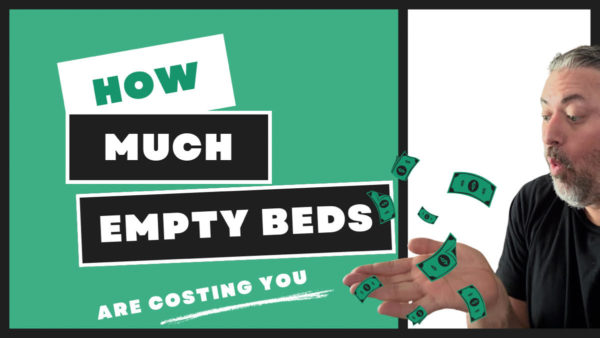
Maximizing Occupancy: Weighing the Cost of Empty Beds Against Holding Out for Higher Rates
In the assisted living industry, every empty bed represents a missed revenue opportunity. Facility managers often face a tough decision: stick to a higher pricing target or fill the bed immediately at a slightly lower rate. This choice can directly impact your facility’s cash flow, stability, and growth. By understanding the revenue trade-offs and factoring in the average resident stay, you can make informed decisions that support your facility’s financial health.
Why We Use a Two-Year Period as an Example
According to data from the National Center for Assisted Living (NCAL), the average length of stay for a resident in an assisted living facility is around 22 months (or about 1.8 years). For simplicity, we’ll round this to two years to create a realistic benchmark for evaluating revenue, budgeting needs, and the financial impact of empty beds.
The Impact of Holding Out for Higher Rates
Let’s say you have an empty bed and are holding out for a resident willing to pay $4,000 per month. If you keep the price firm, the bed might remain unfilled for six months before finding someone able to pay the target rate. Here’s how your revenue would add up over the average two-year period:
•6 months of zero revenue during the initial vacancy period.
•18 months at $4,000/month after filling the bed, totaling:
By maintaining the higher price point and waiting six months to fill the bed, you’d bring in $72,000 over the two-year period.
Alternative Scenario: Filling the Bed Immediately at a Lower Rate
Now, consider the alternative. If you choose to fill the bed immediately at $3,000/month, you’d create a steady revenue stream without an initial waiting period. Over two years, this would generate:
•24 months at $3,000/month:
This alternative scenario also results in $72,000 over the two years, matching the revenue from holding out for a resident at $4,000/month after a six-month vacancy.
Formula for Decision-Making
To determine the lowest rate you could accept from the start (without losing revenue by holding out for a higher price), use this formula:
•Divide your target monthly rate by 1.33 (for a 6-month vacancy period) to find the minimum rate needed to match the income over the average two-year stay.
For example, if your target rate is $4,000/month, accepting $3,000/month right away would generate the same revenue over two years as maintaining the higher rate with an initial six-month vacancy.
Benefits of Filling Beds Immediately
1.Improved Cash Flow

Filling beds sooner ensures immediate revenue, covering ongoing expenses like staffing, utilities, and maintenance. This improves your facility’s financial health, especially with residents typically staying an average of two years.
2.Revenue Compounding Over Time

Accepting a slightly lower rate but achieving full occupancy adds up over time. Consistent occupancy across the average resident stay often results in a more sustainable revenue stream than holding out for a higher rate.
3.Predictable Budgeting and Planning

A steady revenue stream provides stability, making budgeting and forecasting easier. With cash flow in place, you can make confident financial decisions, reinvest in the facility, and avoid seasonal revenue dips.
Weighing the Pros and Cons
•Higher Rate, Longer Vacancy: If your facility’s cash flow is strong, holding out for a higher rate could work, but it requires balancing the risk of prolonged vacancies.
•Lower Rate, Immediate Occupancy: For facilities looking to maximize cash flow and occupancy, filling beds sooner at a reasonable rate typically delivers a more sustainable outcome over the average resident’s stay.
Making the Decision
Ultimately, the choice to hold out for a higher-paying resident or fill a bed immediately depends on your facility’s financial priorities. Factoring in the average resident stay and using the provided formula can help you assess the revenue impact and determine the rate that best aligns with your objectives. By adopting a flexible approach to pricing, you’ll keep occupancy high, stabilize cash flow, and set your facility on a path to long-term growth.
In short, while sticking to the “ideal” rate may seem appealing, consistent occupancy often proves to be the wiser financial choice, ensuring your facility’s stability and success over time.







